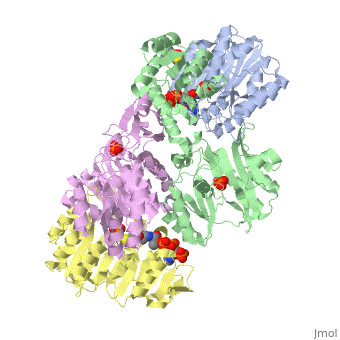1cqj
From Proteopedia
CRYSTAL STRUCTURE OF DEPHOSPHORYLATED E. COLI SUCCINYL-COA SYNTHETASE
Structural highlights
FunctionSUCD_ECOLI During aerobic metabolism it functions in the citric acid cycle, coupling the hydrolysis of succinyl-CoA to the synthesis of ATP and thus represents an important site of substrate-level phosphorylation. It can also function in the other direction for anabolic purposes, and this may be particularly important for providing succinyl-CoA during anaerobic growth when the oxidative route from 2-oxoglutarate is severely repressed. The alpha-subunit binds CoA, as well as ATP and catalyzes phosphoryl transfer to one of its histidine residues. The complete active site is probably located in the region of alpha-beta contact. Evolutionary ConservationCheck, as determined by ConSurfDB. You may read the explanation of the method and the full data available from ConSurf. Publication Abstract from PubMedSuccinyl-CoA synthetase (SCS) catalyzes the following reversible reaction via a phosphorylated histidine intermediate (His 246alpha): succinyl-CoA + P(i) + NDP <--> succinate + CoA + NTP (N denotes adenosine or guanosine). To determine the structure of the enzyme with nucleotide bound, crystals of phosphorylated Escherichia coli SCS were soaked in successive experiments adopting progressive strategies. In the first experiment, 1 mM ADP (>15 x K(d)) was added; Mg(2+) ions were omitted to preclude the formation of an insoluble precipitate with the phosphate and ammonium ions. X-ray crystallography revealed that the enzyme was dephosphorylated, but the nucleotide did not remain bound to the enzyme (R(working) = 17.2%, R(free) = 22.8% for data to 2.9 A resolution). Catalysis requires Mg(2+) ions; hence, the "true" nucleotide substrate is probably an ADP-Mg(2+) complex. In the successful experiment, the phosphate buffer was exchanged with MOPS, the concentration of sulfate ions was lowered, and the concentrations of ADP and Mg(2+) ions were increased to 10.5 and 50 mM, respectively. X-ray diffraction data revealed an ADP-Mg(2+) complex bound in the ATP-grasp fold of the N-terminal domain of each beta-subunit (R(working) = 19.1%, R(free) = 24.7% for data to 3.3 A resolution). We describe the specific interactions of the nucleotide-Mg(2+) complex with SCS, compare these results with those for other proteins containing the ATP-grasp fold, and present a hypothetical model of the histidine-containing loop in the "down" position where it can interact with the nucleotide approximately 35 A from where His 246alpha is seen in both phosphorylated and dephosphorylated SCS. ADP-binding site of Escherichia coli succinyl-CoA synthetase revealed by x-ray crystallography.,Joyce MA, Fraser ME, James MN, Bridger WA, Wolodko WT Biochemistry. 2000 Jan 11;39(1):17-25. PMID:10625475[1] From MEDLINE®/PubMed®, a database of the U.S. National Library of Medicine. See AlsoReferences
| ||||||||||||||||||||


